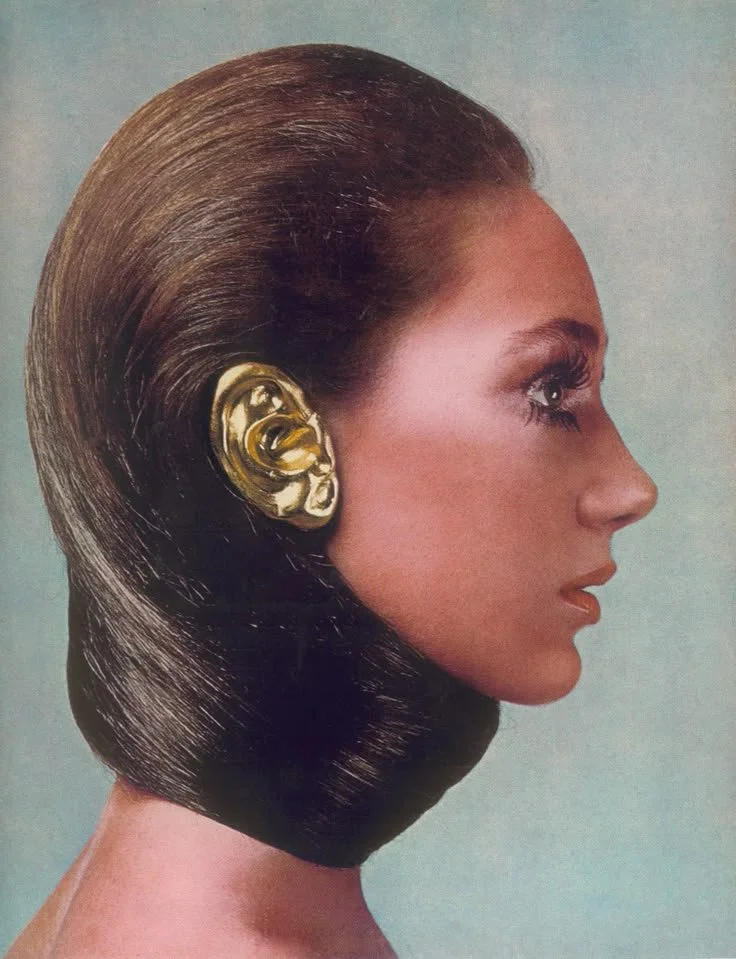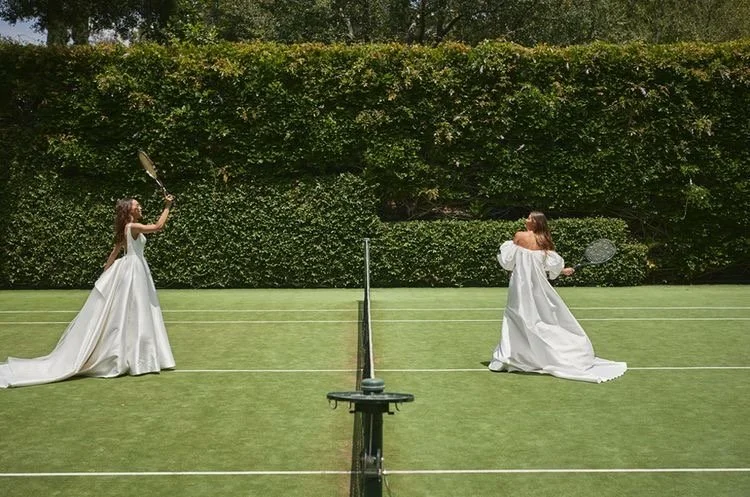Escaping the Algorithm: A Step-by-Step Guide to Finding Your Identity Through Style
Credit: Eduardo Costa, "Fashion Fiction 1", 1968 for Vogue.
Escaping the Algorithm: A Step-by-Step Guide to Finding Your Identity Through Style
Not a guide, really. Just a quiet invitation to remember what dressing for yourself used to feel like.
Personal style is about intimacy. The circled hoops, the beloved red ballet flats, the leather jacket you thrifted on a cold, lucky afternoon—it’s the kind of closeness that feels like sharing headphones or whispering a secret you didn’t think you’d ever tell.
These seemingly mundane acts of connection tend to carry so much weight when it comes to exploring individuality—who we are without filters or references. When we share music with someone, we invite them into the world of our emotions and inner narratives. We bridge the gap and create a moment of euphony.
Style works the same way. It’s not just a look, but a relationship. A slow, quiet rhythm between you and the clothes you choose to live in.
But in an era defined by parasocial style, the lines between our true selves and the personas we see on screens have blurred. The algorithm. The endless scroll. We fall deeper into the internet’s rabbit hole, until individuality dissolves into moodboards and microtrends. We pick up habits and aesthetics from people we’ve never even met. In this fluid space, we’re not just influenced—we’re slowly reshaped, morphing into a mosaic of borrowed personas, a fragmented version of the self we once knew.
But what if we tried to find our way back?
Back to the version of ourselves who made playlists for no one in particular. Who got dressed for the walk to the corner store like it meant something. Maybe our clothes knew us then—before the scroll got louder than our own taste.
Maybe it’s not about building a wardrobe. Maybe it’s about rebuilding a relationship. Not with a map, but with rhythm. With the quiet return to what still feels like yours.
Step One: Delete Your Pinterest Board (Temporarily)
I’ll be honest. While trying to articulate what personal style even means, I’ve ironically come to the conclusion that maybe it’s still not something I’ve fully discovered for myself. I like butter yellow. I wear wide-leg jeans. I get inspired by the micro-trends on my For You Page.
But the other day, somewhere between a dozen open tabs and another minute of scrolling through Substack, I came across a think piece by @MissTyped. One line has stayed with me since:
“And that was the first real, unsettling realization: I had let the internet be the mirror that told me who I was. I had spent so long performing myself online that without social media, I wasn’t sure how to measure my own existence. What is a life unposted? What are thoughts that no one else can hear? Who am I, if not a series of updates and images, strategically packaged for consumption?”
And just like that, the Pinterest board I’d been curating for months—perfect, seasonal, trend-aware—started to feel like someone else’s closet. Someone I might follow, but not someone I am. Who am I without it? What would I wear if suddenly all of my boards were gone?
In Liquid Modernity, sociologist Zygmunt Bauman writes about the fluid nature of identity—how in today’s world, we’re constantly reshaping ourselves, adapting to new versions of who we’re expected to be. There’s no longer a fixed self to return to, just a series of shifting reflections. Pinterest boards. Saved posts. Moodboards curated by an algorithm that knows your taste better than you do. And the strangest part? You start to feel like the reflection isn’t you anymore. Just a pattern you’ve been following, without asking where it’s actually leading.
So no, I’m not going to tell you to “figure out your aesthetic without pinterest inspo.” Instead, what I’m aiming to say: try shutting it all off. For a while. Write a list of the textures, colors, silhouettes you’re drawn to. What feels like you—not what looks like the algorithm’s best guess.
You’re allowed to like contradictions. You’re allowed to change your mind. You’re allowed to dress like five different versions of yourself in one week. No one’s scoring you.
Credit: Mother Washing Dishes, Susan Meyers
Step Two: When You Stop Scrolling, You Start Seeing.
There’s a kind of inspiration that doesn’t live online. It lives in motion—in an unbuttoned coat, chipped nail polish gripping a coffee cup, the way someone’s headphones match their socks (and probably not on purpose).
You only notice it when you’re not trying to. On the bus. In line at the grocery store. Across the café, where someone is wearing clashing prints with the kind of confidence you only get from not caring anymore.
This isn’t about copying a look—it’s about paying attention. About watching how people wear their lives. The teenage boy in a hoodie that fits like armor. The woman in vintage kitten heels and a grocery tote like it’s Chanel. These aren’t just outfits. They’re decisions. They’re habits. They’re stories stitched together with thread, weather, and daily routine.
You can find a similar pattern in filmmaking. The unnecessary detail in a costume, the specific color of a t-shirt, or the unusual arrangement of rings on fingers—these elements aren’t random. They’re foreshadowing. Clues to what came before or what’s coming next. It’s an open door to dive into the character’s internal world, the emotional undercurrents, and what’s about to unfold. But most people don’t notice. They think it’s just a cool outfit.
In reality, style holds the same power. It’s not just aesthetic—it’s emotional architecture. A tool for telling a story—often before we even speak. It signals change, comfort, tension, softness. You just have to slow down enough to see it.
Sometimes the best way to find your style is to stop searching—and just start noticing.
Credit: Mathieu Walter
Editor’s note: If you’re short on time for real-world people-watching, try curated street-style media (e.g. @street.style.hunter )
Step 3: Dress Like No One’s Watching
You’ve cleared the board. You’ve looked around. Now it’s time to return to yourself—not the curated version, not the aesthetic. Just... you. The one who gets dressed for the way it feels to move, to exist, to feel a little more like yourself again. Try it without the pressure. No outfit check. No audience. Just you, in the quiet. In the in-between.
You don’t have to sing for the crowd. The shower works just fine—as long as you mean it.
Pick something you haven’t worn in a while. Something you almost gave away. Something that doesn’t match your aesthetic—whatever that even means anymore. Put it on. Don’t ask if it’s cute. Don’t ask if it’s “you.” Just ask how it feels. Where it lands on your body. What version of you shows up when you wear it.
You’re not trying to make a statement. You’re just trying to hear your own voice again.
Credit: Monique Lhuillier Bridal
Step 4: Action
So what do you do with all of this? Try the outfit. Wear the wrong thing. Forget to take the photo. Just see what happens.
Maybe that’s all personal style really is: a quiet kind of closeness. A rhythm you learn to hear again. A relationship you build slowly—with your past, with your present, with the version of you that doesn’t need an audience.
You don’t have to dress for the scroll. You just have to dress like someone who’s learning to listen.
Editor’s note: If you’re craving something more guided—but still deeply personal—our Style Sessions are designed for exactly this. Quiet, intentional, one-on-one consultations that help you reconnect with your taste and build a wardrobe that feels like a diary, not a display. No algorithms, no pressure. Just style that starts with you.



